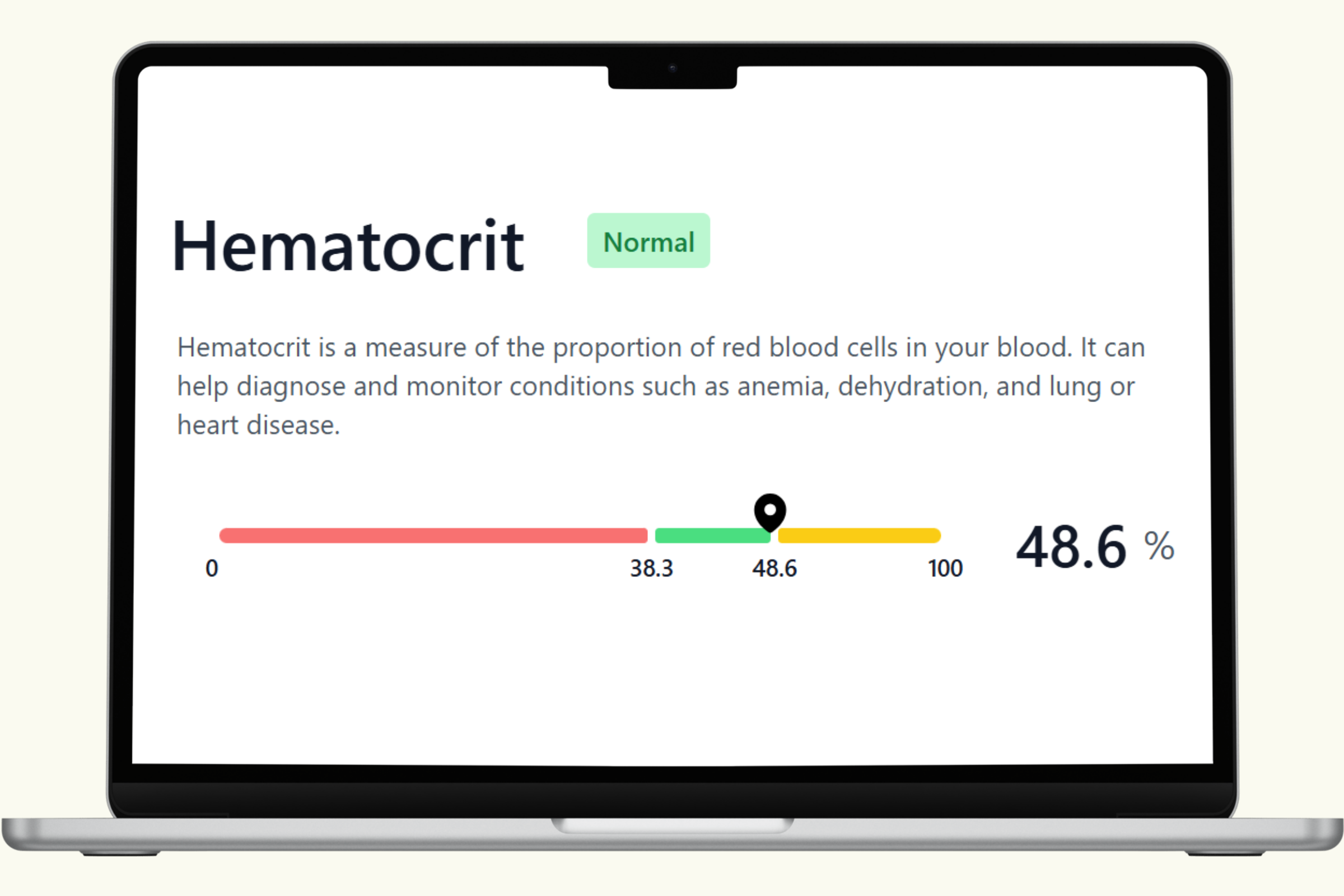Hematocrit (HCT) Blood Test: Measuring Oxygen-Carrying Capacity and Overall Health
The Hematocrit (HCT) Blood Test, included in the PlexusDx Nutrition Deficiency Blood Test, measures the percentage of your blood volume made up of red blood cells (RBCs). Since red blood cells are responsible for transporting oxygen from the lungs to every tissue in the body, hematocrit levels directly reflect how efficiently your body delivers oxygen. Abnormal results may point to anemia, dehydration, or other blood-related conditions, making this test a key marker of both nutritional status and overall health.
What Is Hematocrit?
Hematocrit is the proportion of blood composed of red blood cells, expressed as a percentage. For example, a hematocrit level of 42% means that 42% of your blood is made up of red blood cells, while the rest consists of plasma and other blood components such as white blood cells and platelets. Because red blood cells carry hemoglobin, which binds oxygen, hematocrit serves as a powerful measure of your body’s oxygen-carrying capacity.
Why Is the Hematocrit Test Important?
Hematocrit is a standard part of complete blood counts (CBCs), but it also holds value when measured independently as part of nutritional and health screening. It provides insights into:
- Oxygen delivery – Higher hematocrit generally means greater oxygen-carrying capacity, while low hematocrit suggests reduced oxygen delivery to tissues.
- Anemia detection – Low hematocrit is one of the hallmark indicators of anemia, often caused by iron, folate, or vitamin B12 deficiency.
- Hydration status – Dehydration can temporarily increase hematocrit by concentrating red blood cells relative to plasma.
- Chronic disease monitoring – Kidney disease, bone marrow disorders, and some chronic illnesses may affect hematocrit levels.
- Performance and energy – Since red blood cells supply oxygen for energy metabolism, hematocrit is an important marker for stamina and recovery.
Hematocrit Reference Ranges
Hematocrit levels are reported as percentages. Normal ranges vary by age and sex:
- Men: 41 – 50%
- Women: 36 – 44%
- Children: 36 – 40%
- Newborns: 45 – 61%
- Functional/optimal range: Men: 44 – 48%, Women: 38 – 42% (reflecting ideal oxygen balance without excess viscosity)
Values outside these ranges may signal underlying health issues that require further evaluation.
What Low Hematocrit Levels Mean
Low hematocrit, known as anemia, can have multiple causes:
- Iron deficiency – The most common cause of low hematocrit, often due to poor intake, blood loss, or increased demand (e.g., pregnancy).
- Vitamin B12 or folate deficiency – Impairs red blood cell production, leading to megaloblastic anemia.
- Chronic disease – Kidney disease and inflammatory disorders may lower hematocrit by reducing red blood cell production.
- Blood loss – Heavy menstrual cycles, gastrointestinal bleeding, or injury can reduce hematocrit.
- Bone marrow conditions – Disorders that impair red blood cell formation.
Symptoms of low hematocrit may include fatigue, dizziness, shortness of breath, pale skin, and poor exercise tolerance.
What High Hematocrit Levels Mean
Elevated hematocrit, known as polycythemia, may result from:
- Dehydration – Reduced plasma volume temporarily raises hematocrit.
- Chronic lung disease – Low oxygen levels trigger increased red blood cell production.
- High altitude living – Adaptation to low-oxygen environments increases hematocrit.
- Smoking – Reduces oxygen delivery, prompting higher red blood cell counts.
- Polycythemia vera – A rare bone marrow disorder that overproduces red blood cells.
High hematocrit can make blood thicker, increasing the risk of clotting, heart attack, or stroke if not addressed.
Hematocrit and Nutrition
Nutrition plays a central role in maintaining healthy hematocrit levels. Adequate intake of iron, vitamin B12, folate, and protein is essential for red blood cell production. Deficiencies in these nutrients are among the most common causes of low hematocrit worldwide. On the other hand, hydration status significantly affects hematocrit, making it important to consider fluid balance when interpreting results.
At-Home Hematocrit Testing with PlexusDx
With the PlexusDx Nutrition Deficiency Blood Test, you can measure hematocrit and related biomarkers easily at home using a dried blood spot sample on an ADX card. This method offers:
- Convenience – Collect your sample without visiting a lab.
- Accuracy – Reliable measurement of hematocrit and nutrient markers.
- Actionable insights – Results help identify anemia, nutritional deficiencies, or hydration concerns early.
Who Should Consider a Hematocrit Test?
A hematocrit test is useful for individuals who:
- Experience persistent fatigue, weakness, or dizziness
- Have heavy menstrual cycles or unexplained blood loss
- Follow diets low in iron, folate, or vitamin B12
- Live at high altitudes or smoke
- Have kidney disease, lung disease, or other chronic illnesses
- Want a baseline measure of oxygen delivery and nutritional status
Take Charge of Your Health with PlexusDx
The Hematocrit Blood Test, part of the PlexusDx Nutrition Deficiency Blood Test, provides a clear picture of your red blood cell levels and oxygen-carrying capacity. By detecting anemia, dehydration, or other imbalances early, you can take steps to optimize your nutrition, hydration, and overall health. With simple at-home collection and fast results, PlexusDx makes it easy to monitor one of the most important markers of vitality.
Order your PlexusDx Nutrition Deficiency Blood Test today and gain valuable insight into your hematocrit levels, red blood cell health, and long-term wellness.

Share:
Folate (B9) Blood Test
Homocysteine Blood Test